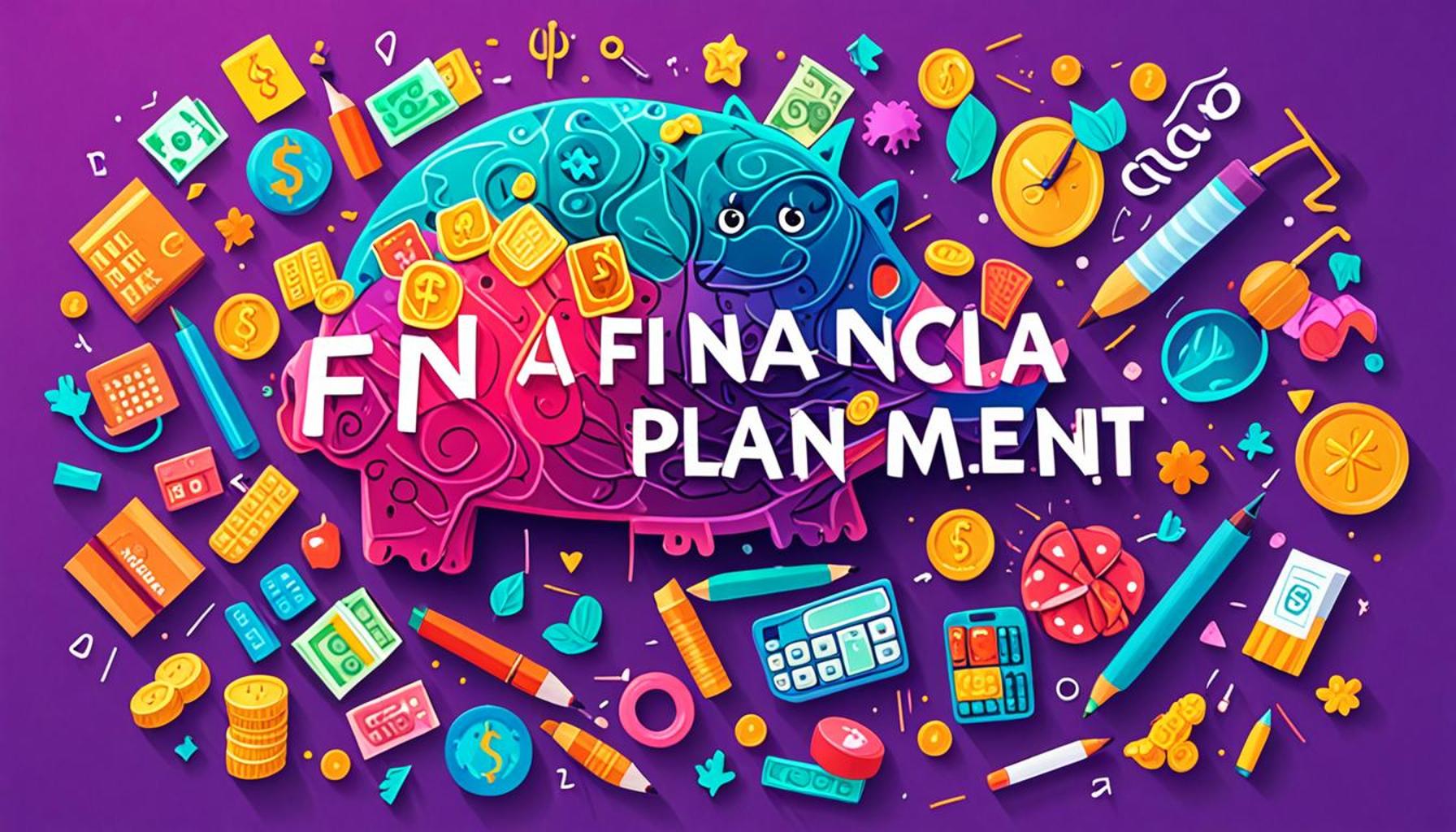How Technology Is Transforming Personal Financial Planning

The Financial Revolution at Your Fingertips
As technology evolves, traditional personal finance methods are being overshadowed by an incredibly dynamic array of digital solutions. The world of finance is no longer confined to banks and physical ledgers; instead, it thrives on innovation and convenience. In the United States alone, millions of consumers are leveraging technology to navigate their financial landscapes more effectively.
Accessibility: One of the most compelling aspects of technology in finance is its widespread accessibility. Financial tools, whether it be an app for managing bills, tracking expenses, or investing, can now be accessed with just a smartphone or a computer. According to a recent survey, approximately 76% of Americans use mobile banking services, highlighting the shift towards digital interactions. Various apps, such as Mint and YNAB (You Need A Budget), provide features that help users keep a close eye on their cash flows and savings—all from the convenience of their smartphones.
Real-time tracking: The ability to track financial activity in real time is another game-changer. By providing immediate visibility into one’s spending habits, consumers can make informed decisions swiftly. Imagine reviewing your bank statement while standing in line at a coffee shop; with apps syncable to your bank accounts like Personal Capital or Acorns, this becomes a reality. These tools not only give users immediate insights into where their money is going but also allow for quick adjustments, such as reallocating funds instantly to better suit their financial goals.
Personalized insights: What sets many modern financial tools apart is the use of advanced algorithms that analyze user data to offer customized advice. These tailored insights can guide users in budgeting, suggest new investment opportunities, or even alert them to potentially harmful spending patterns. For example, a user of a budgeting app might receive a notification suggesting they allocate more funds to their retirement accounts based on their financial trajectory, ensuring they stay on track for their long-term goals.
The adoption of automated savings programs and robo-advisors also signifies a major shift in personal finance. Services like Digit automatically siphon off small amounts of money from checking accounts into savings based on spending patterns. Similarly, robo-advisors such as Betterment and Wealthfront use algorithms to create and manage investment portfolios tailored to the user’s financial goals and risk tolerance, making investing accessible to even those with minimal knowledge of the stock market.
As we continue to explore the transformative influence of technology on personal finance, it is essential to recognize that these advancements not only streamline our financial journeys but also empower us with enhanced knowledge and tools to effectively navigate our economic environments. By embracing these innovations, individuals can take charge of their financial futures and make decisions that resonate with their personal aspirations and situations.
DISCOVER MORE: Click here for the application guide
Empowering Users Through Financial Education
The rise of technology in finance has also propelled financial education into the spotlight, making it more accessible than ever before. With resources available at the tip of one’s fingers, consumers can significantly enhance their financial literacy. Educational platforms, such as Khan Academy and Smart About Money, provide free courses that cover topics ranging from budgeting basics to investment strategies. This democratization of knowledge empowers users to make informed financial decisions, ensuring they aren’t just relying on instinct or hearsay when it comes to their money.
Engaging tools and gamification have emerged as particularly effective methods for enhancing financial literacy. Many apps incorporate game-like features to engage users, turning mundane financial tasks into rewarding challenges. For instance, apps like Qapital help users save money through customizable goals and rewards systems, allowing them to turn saving into a fun activity rather than a chore. This user-centric approach encourages consistent engagement, making the journey toward financial stability not just more effective but also enjoyable.
Moreover, technology has significantly improved the availability of financial advisors. The traditional model of a face-to-face meeting with a financial advisor is being replaced by virtual consultations, which can be accessed from anywhere with an internet connection. This shift is particularly advantageous for individuals who may have limited access to local financial services or those seeking specialized advice without geographical constraints. Platforms like Ellevest cater specifically to women’s financial needs, while others like Facet Wealth provide personalized financial coaching tailored to individual goals.
In addition to expanding access to knowledge and advice, technology is fostering a new level of financial transparency. Consumers can now easily compare fees, interest rates, and services offered by different financial institutions. Websites such as Bankrate and Credit Karma equip users with the tools to make informed choices regarding their savings accounts, loans, and credit cards. This ability to shop around empowers consumers to secure the best possible financial deals, which can translate into substantial savings over time.
- Comparative analysis: Users can effortlessly compare financial products.
- Transparent services: Understanding the full range of fees and rates associated with financial products.
- Informed decisions: Ability to choose the best options that suit personal financial goals.
The innovation brought forth by technology in personal financial planning signifies that consumers can no longer afford to be passive participants in managing their finances. With an abundance of resources, tools, and enhanced accessibility, individuals are better positioned to take control of their financial futures. As we delve deeper into the effects of technology on finance, it’s crucial to acknowledge how these advancements are not just changing the landscape—they are revolutionizing how we perceive and interact with our personal finances, ultimately leading to a more financially savvy society.
DON’T MISS OUT: Click here to learn how to apply
Innovation in Financial Tools and Platforms
As technology continues to evolve, so too do the tools available for personal financial planning, providing consumers with innovative solutions to better manage their finances. One major area of transformation is in the realm of budgeting apps. Unlike traditional spreadsheets or pen-and-paper methods, modern applications are designed with intuitive interfaces that track spending automatically. Apps like Mint and You Need A Budget (YNAB) sync with users’ bank accounts to provide real-time insights into their financial habits. With features that categorize spending, set budget limits, and send alerts when users approach their thresholds, these tools give consumers a clear picture of where their money goes, equipping them to make proactive adjustments.
The integration of artificial intelligence (AI) into personal finance platforms is another exciting advancement. AI-powered tools analyze spending patterns to offer tailored financial advice. For instance, platforms such as Clearscope and Clarity Money use machine learning algorithms to suggest personalized savings plans or expenditures, allowing users to achieve their financial goals more efficiently. As technology detects patterns and trends in individual financial behaviors, it can even provide insights for investments based on current market conditions, maximizing the potential for returns.
Moreover, the advent of robo-advisors has disrupted the traditional financial advisory landscape. For investors, platforms such as Betterment and Wealthfront leverage algorithms to create and manage diversified investment portfolios based on an individual’s risk tolerance and investment goals. This automated management offers low fees and accessibility that were previously unavailable to the average investor, making it feasible for more individuals to engage in long-term investment strategies.
Additionally, technology has played a pivotal role in retirement planning. The rise of 401(k) management platforms and retirement calculators allows individuals to estimate their needs, track their progress, and adjust their savings accordingly. For example, tools like Personal Capital enable users to visualize their retirement trajectory, emphasizing the importance of saving early and strategically. These resources demystify the often-overwhelming aspects of retirement planning, helping individuals to envision a secure future.
Another groundbreaking aspect of technology in personal finance is the rise of blockchain and cryptocurrency. While still emerging, these technologies have begun to reshape how individuals think about currency and investments. By using blockchain technology, transactions become faster and more secure, reducing reliance on traditional banking infrastructures. This could lead to a more inclusive financial landscape, particularly for unbanked populations or those in underserved communities. As cryptocurrencies evolve, so does the debate on financial literacy, especially with the increasing emphasis on understanding digital assets and their potential risks.
- Automated budgeting: Simplifying tracking expenses through sync features in budgeting apps.
- AI insights: Tailored financial recommendations based on user-specific spending data.
- Robo-advisors: Low-cost investment management democratizing access to personalized investment strategies.
- Retirement tools: Comprehensive retirement planning resources that visualize savings goals.
- Blockchain potential: Shaping the future of currency and financial transactions for broader access.
As these innovations continue to surface, they not only reshape individual financial planning but also challenge conventional views on financial management, encouraging consumers to explore and adopt new approaches that suit their unique situations. The technological revolution in personal finance invites individuals to abandon the old paradigms of money management and embrace a more dynamic, informed, and proactive financial future.
DISCOVER: Click here for application tips
Conclusion
In summary, technology is acting as a catalyst for profound changes in personal financial planning, marking a shift toward more accessible, efficient, and customized financial management strategies. With the emergence of innovative tools—from user-friendly budgeting apps to sophisticated AI-driven insights—individuals are now better equipped to understand and control their finances. The democratization of investing through robo-advisors has made it possible for a broader audience to participate in the financial markets, while advanced retirement planning platforms enable savers to visualize and optimize their paths to financial independence.
Moreover, the ongoing development of blockchain and cryptocurrencies is challenging traditional notions of currency and investing, heralding a new era of financial transactions that promise speed, security, and inclusivity for previously underserved populations. As individuals embrace these technologies, they gain the ability to make informed decisions that can lead to better financial outcomes.
As the landscape continues to evolve, it is essential for consumers to remain proactive and informed about the tools available to them. Engaging with these innovations can offer unprecedented opportunities not only to enhance individual fiscal responsibility but also to foster financial literacy in a rapidly changing economy. Ultimately, leveraging technology in personal finance serves as a powerful reminder that the future of financial planning is not just about number-crunching; it’s about empowerment, creativity, and the journey towards financial well-being.


